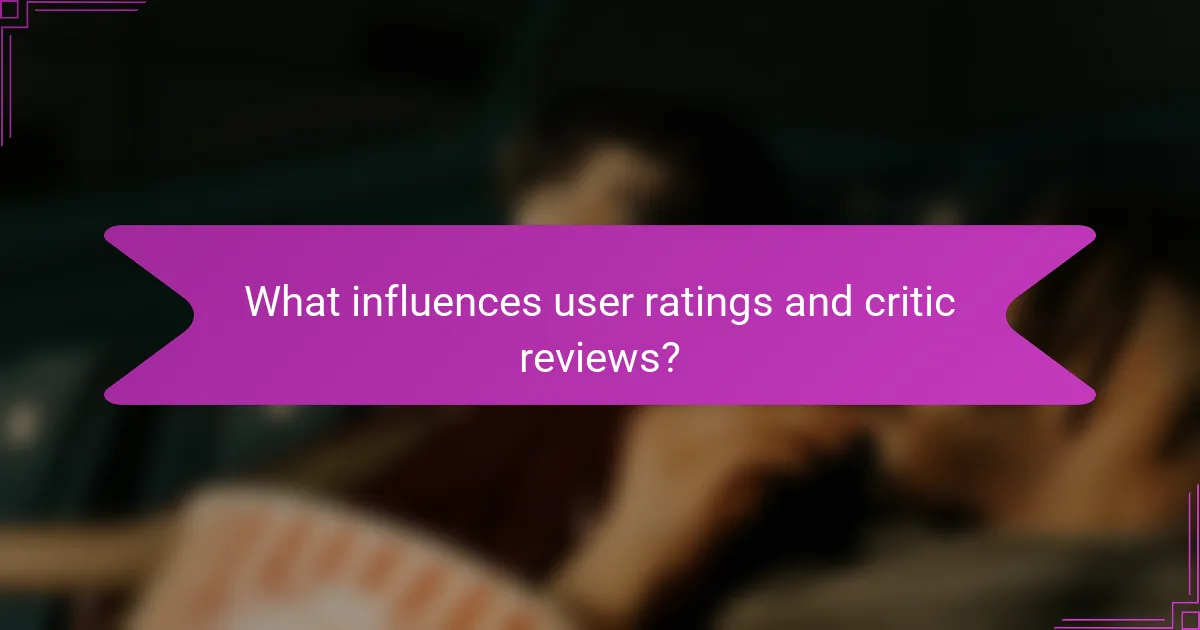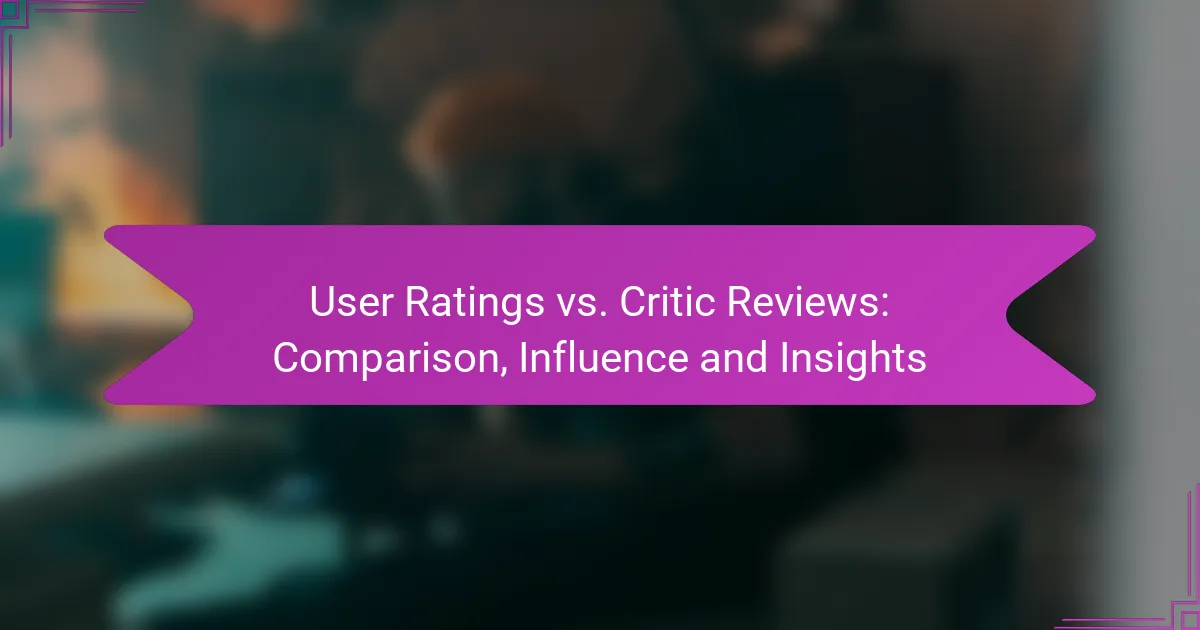User ratings and critic reviews serve as two distinct lenses through which audiences evaluate movies, games, and products. While user ratings capture the sentiments of the general public, critic reviews offer a more analytical perspective, often focusing on technical and artistic elements. Understanding the interplay between these two forms of feedback can provide valuable insights into consumer behavior and preferences.

How do user ratings compare to critic reviews?
User ratings often reflect the general audience’s sentiment, while critic reviews provide expert analysis. Both play significant roles in shaping perceptions of movies, games, and products, but they can differ widely in tone and content.
User Ratings Overview
User ratings are typically gathered from everyday consumers who share their experiences and opinions on platforms like IMDb, Rotten Tomatoes, or product review sites. These ratings usually take the form of a numerical score or star rating, allowing potential buyers to gauge overall satisfaction quickly.
User ratings can be influenced by factors such as personal preferences, social trends, and marketing efforts. For example, a popular film may receive high ratings simply due to its buzz, regardless of its artistic merit.
Critic Reviews Overview
Critic reviews are written by professionals who analyze content based on established criteria, including storytelling, technical execution, and cultural impact. Critics often publish their reviews in newspapers, magazines, or specialized websites, providing a more nuanced perspective than user ratings.
Key Differences
The primary difference between user ratings and critic reviews lies in their sources and intentions. User ratings reflect personal opinions, often leading to a more emotional response, while critic reviews aim for a balanced analysis based on expertise.
Another key difference is the audience reach; user ratings can be influenced by mass appeal, while critics may focus on niche elements that resonate with specific audiences. This can lead to discrepancies, where a critically acclaimed film may not perform well with general audiences.
When considering both, it’s essential to balance user ratings with critic reviews to gain a comprehensive understanding of a product or film’s quality. Look for patterns in both types of feedback to make informed decisions.

What influences user ratings and critic reviews?
User ratings and critic reviews are shaped by various factors, including personal preferences, expectations, and the context in which the content is consumed. While user ratings often reflect individual experiences, critic reviews typically consider broader criteria such as technical quality and artistic merit.
Factors Affecting User Ratings
User ratings are influenced by personal taste, emotional responses, and the context of consumption. For instance, a user might rate a movie higher if they watched it with friends or during a special occasion, while a negative experience, such as technical issues, can lead to a lower score.
Additionally, the timing of a rating can play a role. Users may be more generous immediately after a positive experience, but their ratings might change over time as they reflect on the content. It’s common for ratings to fluctuate based on trends or social media influence.
Factors Affecting Critic Reviews
Critic reviews are shaped by a more analytical approach, focusing on elements like storytelling, direction, and production quality. Critics often have established criteria and industry knowledge that guide their evaluations, which can lead to more consistent assessments compared to user ratings.
Moreover, critics may consider the cultural and historical context of a work, assessing its significance beyond immediate enjoyment. This can result in a divergence between critic reviews and user ratings, as critics might appreciate artistic choices that resonate differently with general audiences.

How do user ratings impact consumer decisions?
User ratings significantly influence consumer decisions by providing insights into the experiences of others. Potential buyers often rely on these ratings to gauge product quality, trustworthiness, and overall satisfaction before making a purchase.
Influence on Purchase Behavior
User ratings can directly affect purchase behavior, as consumers frequently check reviews before deciding to buy. A product with high ratings often leads to increased sales, while low ratings can deter potential buyers. For example, a smartphone with an average rating above 4 stars may see sales increase by a notable percentage compared to a similar model rated below 3 stars.
Many consumers use a heuristic where they look for a minimum rating threshold, typically around 4 stars, before considering a purchase. This threshold can vary by product category, with some items requiring even higher ratings to instill confidence.
Impact on Brand Reputation
User ratings play a crucial role in shaping brand reputation. Brands that consistently receive high ratings are often viewed as more reliable and trustworthy, which can lead to customer loyalty and repeat purchases. Conversely, negative ratings can tarnish a brand’s image, making it harder to attract new customers.
For instance, a restaurant with a high average rating on platforms like Yelp or TripAdvisor is likely to enjoy a steady stream of patrons, while a drop in ratings can lead to a sharp decline in foot traffic. Brands should actively monitor and respond to user feedback to maintain a positive reputation and address any concerns promptly.

What role do critic reviews play in the market?
Critic reviews significantly influence consumer perception and purchasing decisions in the market. They provide expert evaluations that can enhance a product’s credibility, often swaying potential buyers toward or away from a purchase.
Authority and Trustworthiness
Critic reviews are often seen as more authoritative than user ratings because they come from professionals with expertise in the field. This authority can build trust among consumers, as they rely on critics to provide informed opinions based on experience and analysis.
For instance, a film review from a well-known critic can carry more weight than numerous user ratings, especially for discerning audiences. Consumers tend to gravitate towards products that have received favorable reviews from trusted sources, reinforcing the importance of critic evaluations.
Effect on Sales and Marketing
Positive critic reviews can lead to a notable increase in sales, often translating to higher revenue for businesses. Products that receive high ratings from critics may see sales boosts ranging from 20% to 50%, particularly in competitive markets.
Marketers often leverage these reviews in promotional materials, using quotes or ratings to attract potential customers. However, relying solely on critic reviews can be risky; businesses should also pay attention to user feedback to maintain a balanced perspective and address any concerns that may arise.

How can businesses leverage user ratings and critic reviews?
Businesses can effectively leverage user ratings and critic reviews to enhance their reputation and drive sales. By understanding the strengths and weaknesses highlighted in both types of feedback, companies can make informed decisions to improve their products and marketing strategies.
Strategies for Enhancing User Engagement
To boost user engagement, businesses should actively encourage customers to leave ratings and reviews. This can be achieved through follow-up emails, loyalty programs, or incentives like discounts on future purchases. Engaging with users by responding to their feedback, whether positive or negative, fosters a sense of community and trust.
Creating an easy and accessible review process is essential. Consider integrating review prompts on your website or app, ensuring they are user-friendly and straightforward. This can lead to a higher volume of feedback, providing a more comprehensive view of customer sentiment.
Utilizing Critic Reviews for Marketing
Critic reviews can serve as powerful marketing tools, enhancing credibility and attracting new customers. Highlighting positive reviews in promotional materials, such as social media posts or advertisements, can significantly influence potential buyers. Make sure to select reviews from reputable sources to maximize their impact.
Incorporating critic reviews into your website can also improve user trust. Consider creating a dedicated section for expert opinions or testimonials, which can help potential customers feel more confident in their purchasing decisions. Regularly updating this section with fresh reviews keeps your content relevant and engaging.

What are the emerging trends in user ratings and critic reviews?
Emerging trends in user ratings and critic reviews highlight a shift towards more interactive and technology-driven feedback mechanisms. Social media platforms and AI integration are reshaping how consumers and critics share their opinions, influencing purchasing decisions and brand reputations.
Influence of Social Media
Social media has become a powerful tool for both users and critics to express their opinions on products and services. Platforms like Twitter, Instagram, and TikTok allow for real-time feedback, often leading to viral trends that can significantly impact a brand’s image.
Brands are increasingly monitoring social media sentiment to gauge public perception. This can lead to quick adjustments in marketing strategies or product offerings based on consumer reactions, demonstrating the immediate influence of user ratings in the digital age.
Integration of AI in Reviews
The integration of AI in reviews is transforming how feedback is generated and analyzed. AI algorithms can aggregate user ratings and identify patterns, providing insights that may not be immediately apparent from individual reviews.
Some platforms are using AI to generate summaries of critic reviews, making it easier for consumers to digest information quickly. However, reliance on AI also raises concerns about authenticity and the potential for bias in automated assessments.
Future of Consumer Feedback
The future of consumer feedback is likely to involve more personalized and interactive experiences. As technology advances, we may see more tools that allow users to provide feedback through voice or video, enhancing engagement and detail in reviews.
Additionally, the rise of blockchain technology could ensure the authenticity of reviews, making it harder for fake ratings to influence consumer decisions. Brands that adapt to these changes will likely gain a competitive edge in understanding and responding to consumer needs.



